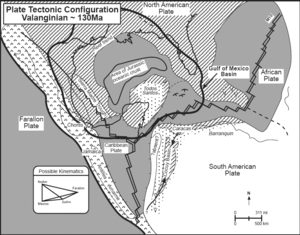Plate tectonics: setting and history maps
| Exploring for Oil and Gas Traps | |

| |
| Series | Treatise in Petroleum Geology |
|---|---|
| Part | Critical elements of the petroleum system |
| Chapter | Sedimentary basin analysis |
| Author | John M. Armentrout |
| Link | Web page |
| Store | AAPG Store |
By understanding the present structural and stratigraphic configuration of a basin, we can interpret its plate tectonic history within the context of global plate reconstructions. Starting with the present configuration of the basin, we can move back in time and map the basin at critical periods in its plate tectonic development. Maps should show features such as spreading centers, contractional areas, extensional areas, crustal types, and mobile belts.
Critical period map

Technically, the Gulf of Mexico (GOM; see General Facts about the Gulf of Mexico for general information) is a Mesozoic-Cenozoic (see International Chronostratigraphic Chart) rift basin formed along a southwest-northeast-spreading center on the southern margin of the North American craton.[2] The basic tectonic architecture developed as a consequence of the Jurassic breakup of Pangea (see Plate Tectonics for more information) as Africa and South America separated from North America.[1] The GOM basin is underlain by oceanic and transitional crust[2] deformed along a set of north-northwest-trending faults.[3]
Figure 1 shows the Gulf of Mexico region as it looked approximately 130 Ma. Note the spreading and transform fault systems separating the North American, Atlantic, Farallon, and Caribbean plates. (See Plates.) Striped areas are cratonic basement; shading is transitional to oceanic basement; and arc-related volcanics are noted by a “A” pattern east of the Farallon/Caribbean trench.
See also
- Cross section
- Regional maps and cross sections
- Making regional tectonic maps
- Making regional structural cross sections
- Structural maps and cross sections
- Determining tectonostratigraphic history
- Using a tectonic history model for petroleum system analysis
References
- ↑ 1.0 1.1 Pindell, J. L., 1993, Regional synopsis of Gulf of Mexico and Caribbean evolution: Proceedings, Gulf Coast Section SEPM 13th Annual Research conference, p. 251–274.
- ↑ 2.0 2.1 Buffler, R. T., 1991, Early evolution of the Gulf of Mexico basin, in D. Goldthwaite, ed., An Introduction to Central Gulf Coast Geology: New Orleans Geological Society, p. 1–16.
- ↑ Marton, G., and R. T. Buffler, 1993, The southeastern Gulf of Mexico in the framework of the opening of the Gulf of Mexico basin: Selected Papers, Gulf Coast Section SEPM 13th Annual Research conference, p. 127–139.